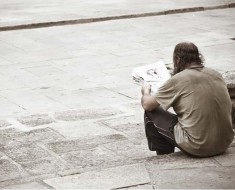Readings – Haggai 1: 15b-2:9
Luke Ch.20: 27-38
1.
Haggai is one of the twelve minor prophets huddled together for warmth at the end of the Old Testament. They have less of the apocalyptic gloom of Ezekiel, the fierce morality of Amos or the stern hopefulness of Isaiah, but they ARE prophetic, they are about the disappointment of God and the possibilities of forgiveness and renewal and can be read through Christian and contemporary eyes, which we must always do when reading the Jewish scriptures.
Haggai’s prophecy is a tiny book, only two chapters and a profusion of dates; Haggai is very keen on facts. So he draws our attention to the period of about 500 years before the Christian era, when Jews were returning from exile in Babylonia and the long yearned-for re-building of the Temple was proving a mighty task, but one that was absolutely essential to the Hebrew psyche.
They couldn’t be themselves unless they were home again; they couldn’t properly be the people God wanted them to be until they had re-built his house. Their two places of being – the land and the Temple. That’s how they defined themselves and indeed how many an orthodox Jew does to this day.
2.
Buildings are important. As memorials, as statements, or as monuments of personal grandeur. Tristam Hunt’s fascinating book ‘Building Jerusalem’ is about the rise and fall of the Victorian city.
Much of the imperial pride of those great northern cities and their mercantile princes was made visible in stone and brick : the Town Halls in Manchester and Leeds, the West Yorkshire Mills and the railway stations all round the country like Brunel’s Temple Meads (‘Temple’? Where did that come from?); they were there to say, ‘this is who we are and we are proud of it’.
More humbly, a building is significant as a home, the place where you come back to. That feeling you have as you finish an immensely exotic holiday, a cruise, a brave visit to Weston Super Mare, a brief visit to see your mother-in-law in Barnsley, whatever – wonderful to be home again, wading through the accumulated post, checking the answer phone, seeing what’s happened to the garden, looking forward to being in your own bed. Even glad to hear the barking of the dog next door. Home again! And that’s a bit of what the church is and Haggai’s longed for temple might be, a sanctuary, a place where you can be yourself and can be refreshed,.
When I was a student, we were divided into groups and associated with particular churches in the city. Mine was Bristol Mission where we had to be around on Sunday evenings, and in particular active on a new estate where on one afternoon of the week we would do door to door visiting. The slowly growing church met in the minister and his wife’s home with hymn books and temporary chairs crashing in on what others would regard as their privacy. A church in a house. But the eventual aim was to build a church and some time after I left college, it was built. I have often wondered how necessary that was and which was the real church where there was space for the Spirit to convey the love of God? The one in a home or the one in a chapel?
3. What does your church building say to you? Are there long family associations so that when you look at this or that pew, your mind fills up with memories? Do you think of the city from which you come and to which you go back – architecturally one piece but also a kaleidoscopic – often fragmented. One of the two churches where I first practised as a minister was built only two years after the death of John Wesley, and the grave of its founder Captain John Webb was below the communion table. There were 58 memorial tablets on the walls. One was more conscious of the church triumphant than the church militant – there were more signs of death than life. What of your church? Does its future matter more to you than its past? What does it to you? Perhaps three things in common with all places of worship.
1. It’s a place to worship God. Obviously enough. A space where we adore, magnify, attend to and cherish the very presence of the ultimate mysterium of life ; God himself. When Hindus, Sikhs and Moslems too enter their places of worship, they take of their shoes for they walk on holy ground. It is very difficult in our casual and uncertain and cynical age to revere anything but unless this building itself and we who come enter it make and honour an environment of holiness and beauty as we are received by the living presence of God, we had better stay at home. Today it is not easy for preachers and for congregations to enter into that dimension of human and divine meeting but our belief in Jesus for whom God was an instant presence, it is our calling and our purpose. I don’t feel comfortable with that line of the hymn ‘I love the place O God wherein thine honour dwells’ – no one should love things even buildings. But let’s love God in this building and wait upon him. Any beauty that exists here, any memories that you cherish pointing to the presence of the unseen one. That old Hebrew word, used when talking of God – ‘awe’, the lost factor in modern worship where mateyness so often takes over from mystery. Catch your breath sometimes when you enter here, for you are not alone. We are evoking the Holy One.
That’s a must for this and any church building. Another, is that it can be
2. a place of hospitality – one of the great neglected words in the Christian vocabulary. I blanch or blush – difficult to do both at once – whenever I see outside often drab and worn out church buildings, the words ‘come and join us’. That’s not hospitality; it’s an attempt at a take over bid. ‘come’ suggests to me some sort of demand ; ‘join’ feels like if you do obey the invitation you may have to make a major life change and ‘us’ implies that you are characterised as being one of ‘them’ and your only ticket for this ride, is to become one of ‘us’. I’m being hyper-critical – all of us try to be accessible -, but hospitality must mean more than that. Must it not be generous, open, studying the needs of the other and allowing people to be themselves. And practical.
Giving hospitality by sharing food, shelter and love is a constant biblical theme and its not one we work at enough. The stranger who joined the disciples on the road to Emmaus was only recognised as Jesus took bread, blessed and broke it. Matthew towards the end of his gospel onnected the welcome we give to God with how we treat people, with this familiar litany – ‘I was hungry and you gave me food. I was thirsty and you gave me something to drink, I was naked and you gave me clothing. I was sick and you took care of me. I was a stranger and you gave me welcome.’
It may be the hardest social grace of a church – how to welcome people. It can be too effusive, it can be non-existent; it can be genuine, it can be false. Some of us are gifted in this way and others of us find making first contact with a person difficult in or out of church. What it often isn’t (our hospitality), is natural, spontaneous and real. I guess all churches need to work at that so that our genuine human engagement is part of our discovery of God : the two united in the sharing of the Eucharist, not a private nibble but a communal Meal.
3.And the other purpose of this building is to plan the revolution. The old temple was the place for life – the sacrifice to re-establish fellowship with God, the spiritual place where God resided, selling and buying took place there too – and it was a place of meeting. I was in a church and there was this woman popping about from pew to pew before the service and then eventually as the service was about to begin, she sat down next to me. ‘I’ve caught up on all the news’ she said. ‘I can settle down now’. Fine! That happened in the outer courts of the temple where even the gentiles were allowed. The news could be shared- and the plotting begin.
Some of the zealots would have been there and Roman spies no doubt hoping to catch them at it; and visionaries and weirdoes, apocalyptic hopefuls waiting for the end of things. The clamour and the chaos of controversy and the possibility of consensus and conclusion. Does that happen here? Should it? I think so O.K. I concede – we do love the place wherein thine honour dwells …but also where the gospel is thrown into the crucible of the real world and ground against the hard truths of contemporary existence and from which some new possibilities of how it is to be church today can emerge. Which I guess is how Julian House in Bath and other homes for the homeless were established, a significant christian sign in our otherwise very established city, of the seeds of social revolution.
1. Back to Haggai. I wonder if those Temple-enthusiasts had an inkling of what those huge inter-locking courts with the inner-sanctuary where God lived, where the memory of the ark was housed, would map out so much of their future? The theology in the bricks and the stones, became so important as to dictate other beliefs – the purity of the nation, the necessity of sacrifice, the elitism of the priestly caste. The building not merely expressing faith, but determining it. And one could add that the present impasse in Israel is a direct consequence of this mystique grown from a building – its weeping walls most of what remains, fixing Jerusalem as the centre and the hope of a race long used to persecution, some members of which have grown blind to the fact that they have now become the persecutors. Some of the seeds of Middle East chaos and cruelty deriving from the extreme reverence given to a building. So we are on dangerous territory here.
2. Jesus is the antithesis of pomp and power and prestige so often associated with buildings, and sets us free from, anything in danger of capturing, holding down, sanitising, making respectable a faith that arises from the man who overturned the tables in the Temple, who prayed on the mountains and who said that when some of his friends were together and they remembered him – ‘never mind where it is, I shall be there too’.
3. He is why this building was built; why he and his conception of the possibilities of communication between the God of all things and all of life, has become the bedrock of our faith. Here in this sacred and public place – a place for worship, for hospitality and for revolution -the fire of our faith can burn. It was all a long time ago and was for a different purpose – that great trek home to rebuild a home for God, but let old Haggai’s faith in God have the last word…’ I am with you, says the Lord of hosts….my spirit abides with you : do not fear’ .





